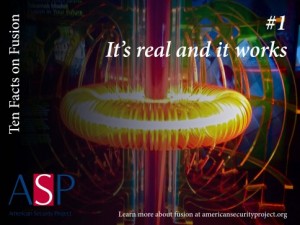Department of Energy Budget Fails Again to Lead on Fusion Energy
 The White House has released the details of their FY16 budget request to Congress. While no observer would expect that President Obama’s budget will be fully enacted by a Republican-controlled Congress, it does provide an important “vision” for where the President wants the country to go.
The White House has released the details of their FY16 budget request to Congress. While no observer would expect that President Obama’s budget will be fully enacted by a Republican-controlled Congress, it does provide an important “vision” for where the President wants the country to go.
And, unfortunately, the Department of Energy’s vision for the next generation in energy is sorely lacking. This budget would cut research into fusion energy by 10% from the 2015 level. It would fund the international ITER project at $150 million, well under what is required to move the program forward. And, it would close MIT’s Alcator C-Mod fusion research facility at the end of FY2016 without a plan for how to replace it.
In the budget justification from the Department of Energy’s Office of Science, Dr. Patricia Dehmer, Acting Director, explained that the president’s FY 2016 budget request for fusion, despite appearing as a 10.2% decrease, is higher than their FY 2015 request. Congress (and House Republicans in particular) have funded the Fusion Energy Sciences program at a significantly higher level than the President proposed in each budget since FY2013. For the future of Fusion energy, we will need to do the same again.
Fusion energy research is simply too important for budgetary games. It should be a priority. With focus and direction, we know that fusion energy research could be accelerated ASP’s report “Fusion Power – A 10 Year Plan to Energy Security” provides an aggressive, but doable, timeline for research and development.
Fusion energy research needs to have an energy mission – we need to move the program from a purely scientific one into a program with a defined mission to produce energy (see ASP’s Op-Ed in the Hill, “U.S. Fusion Program Must Have Energy Mission”). We know that fusion energy will provide a source of power that is clean, secure, safe, and sustainable. If properly funded and directed, fusion energy could power the US into a new role of global scientific leadership.
As ASP wrote in its submission to the House Science Committee when they examined fusion in June, 2014:
With direction from Congress, America’s scientists could begin today to build the next-generation of facilities that will develop and prove the feasibility of fusion power. We know that our competitors in China and Russia have begun work on these facilities. Our superior scientific expertise means that we can beat them: but we first need to get to the starting line.
Achieving practical fusion power will cement American leadership in solving some of the world’s critical problems, and drive American competitiveness in the coming decades.
We cannot wait to get started. It is time for the United States to get serious about fusion.






[…] Department of Energy Budget Fails Again to Lead on Fusion Energy […]
For an organization that gets it’s 10 facts about climate change correct, it is totally amazing and astounding that it then goes completely off the rails with anti-divestment campaign and a campaign for fusion. Makes me wonder if you are not just another inside-the beltway-bunch of VSPs (you know, those Very Serious People) who not only get us into trouble, but never can really figure a way out.
Fusion is a make work project for physicists. Ought to be totally zeroed out in the budget and those funds spent on something that works, and works immediately, not some pie-in-the-sky, decades-from-now magical solution.
So you tell me, how many orders of magnitude is LCF from breakeven? System breakeven is defined as energy in at the wall plug of the power conditioning to wall socket out after conversion from fusion process to useful electrons in the wires to the power distribution system.
I think it’s probably 4 orders.
[…] Department of Energy Budget Fails Again to Lead on Fusion Energy […]